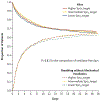Oxygen-Saturation Targets for Critically Ill Adults Receiving Mechanical Ventilation
- PMID: 36278971
- PMCID: PMC9724830
- DOI: 10.1056/NEJMoa2208415
Oxygen-Saturation Targets for Critically Ill Adults Receiving Mechanical Ventilation
Abstract
Background: Invasive mechanical ventilation in critically ill adults involves adjusting the fraction of inspired oxygen to maintain arterial oxygen saturation. The oxygen-saturation target that will optimize clinical outcomes in this patient population remains unknown.
Methods: In a pragmatic, cluster-randomized, cluster-crossover trial conducted in the emergency department and medical intensive care unit at an academic center, we assigned adults who were receiving mechanical ventilation to a lower target for oxygen saturation as measured by pulse oximetry (Spo2) (90%; goal range, 88 to 92%), an intermediate target (94%; goal range, 92 to 96%), or a higher target (98%; goal range, 96 to 100%). The primary outcome was the number of days alive and free of mechanical ventilation (ventilator-free days) through day 28. The secondary outcome was death by day 28, with data censored at hospital discharge.
Results: A total of 2541 patients were included in the primary analysis. The median number of ventilator-free days was 20 (interquartile range, 0 to 25) in the lower-target group, 21 (interquartile range, 0 to 25) in the intermediate-target group, and 21 (interquartile range, 0 to 26) in the higher-target group (P = 0.81). In-hospital death by day 28 occurred in 281 of the 808 patients (34.8%) in the lower-target group, 292 of the 859 patients (34.0%) in the intermediate-target group, and 290 of the 874 patients (33.2%) in the higher-target group. The incidences of cardiac arrest, arrhythmia, myocardial infarction, stroke, and pneumothorax were similar in the three groups.
Conclusions: Among critically ill adults receiving invasive mechanical ventilation, the number of ventilator-free days did not differ among groups in which a lower, intermediate, or higher Spo2 target was used. (Supported by the National Heart, Lung, and Blood Institute and others; PILOT ClinicalTrials.gov number, NCT03537937.).
Copyright © 2022 Massachusetts Medical Society.
Figures



Comment in
-
Oxygen-Saturation Targets for Adults Receiving Mechanical Ventilation.N Engl J Med. 2023 Feb 9;388(6):574. doi: 10.1056/NEJMc2216088. N Engl J Med. 2023. PMID: 36780687 No abstract available.
-
Oxygen-Saturation Targets for Adults Receiving Mechanical Ventilation. Reply.N Engl J Med. 2023 Feb 9;388(6):574-575. doi: 10.1056/NEJMc2216088. N Engl J Med. 2023. PMID: 36780688 No abstract available.
-
Oxygen Targets: Too Much or Too Little; Does It Matter?J Cardiothorac Vasc Anesth. 2023 May;37(5):687-689. doi: 10.1053/j.jvca.2023.01.022. Epub 2023 Jan 31. J Cardiothorac Vasc Anesth. 2023. PMID: 36813628 No abstract available.
References
-
- Wunsch H, Linde-Zwirble WT, Angus DC, Hartman ME, Milbrandt EB, Kahn JM. The epidemiology of mechanical ventilation use in the United States. Crit Care Med 2010; 38: 1947–53. - PubMed
-
- Wunsch H, Angus DC, Harrison DA, Linde-Zwirble WT, Rowan KM. Comparison of medical admissions to intensive care units in the United States and United Kingdom. Am J Respir Crit Care Med 2011; 183: 1666–73. - PubMed
-
- Esteban A, Frutos-Vivar F, Muriel A, et al. Evolution of mortality over time in patients receiving mechanical ventilation. Am J Respir Crit Care Med 2013; 188: 220–30. - PubMed
Publication types
MeSH terms
Substances
Associated data
Grants and funding
LinkOut - more resources
Full Text Sources
Medical
